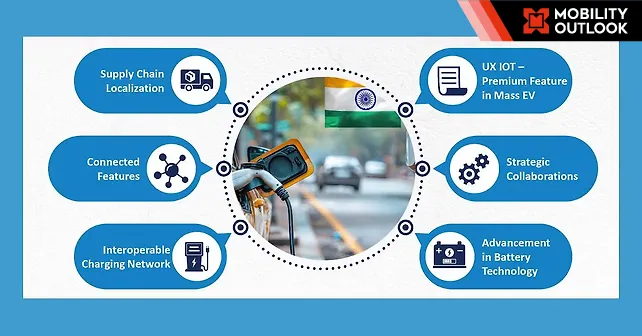India is fast emerging as a key player in the global electric vehicle (EV) landscape, driven by growing localisation, rising adoption of clean mobility, and government-led push for advanced cell development and infrastructure.
As per the latest report by Frost & Sullivan: “India EV Outlook 2025 & Beyond,” the passenger EV sales globally are expected to reach 20 million units in 2025, accounting for over 20% of light-duty vehicle sales. In India, the EV market is also picking up pace, with unit sales projected to rise from 99,004 in 2024 to approximately 138,606 in 2025—a sharp 40% year-on-year growth. Nearly all of these will be battery electric vehicles (BEVs), underlining India’s preference for full-electric solutions over hybrids or fuel-cell variants, which are yet to make inroads.
Leading this surge are SUVs and subcompact SUVs, which dominate the Indian EV landscape. Tata Motors leads the charge with over 61,000 units sold in 2024, followed by MG and Mahindra & Mahindra. Top-selling models include the Tata Punch, Tiago, and Nexon, along with MG’s Comet and Windsor—each reflecting a growing consumer appetite for urban-friendly, tech-enabled electric vehicles, the report said.
This momentum is backed by strong government interventions. From initial incentives supporting direct-to-consumer EV purchases, policy focus has now shifted to component localisation and infrastructure buildout. Flagship schemes like FAME II, PLI, and PM e-Bus Sewa are not only fostering domestic manufacturing but also enabling ecosystem-wide transformation—spanning two- and three-wheelers, buses, and public charging networks.
Charging infrastructure has crossed 25,000 public chargers nationwide, while domestic production of battery packs and electric motors has grown by over 50% since 2022. This rapid localisation is improving supply chain resilience and cost efficiency. Shared mobility operators such as BluSmart and Lithium Urban are also expected to contribute nearly 40% of fleet EV demand by 2030.
Technology innovations are further accelerating the shift. Next-generation battery recycling, 800V EV architecture, and the introduction of driver-assist features in premium EVs are enhancing performance, safety, and affordability. Autonomous fleet pilots are expected to take off in gated community environments, laying early groundwork for broader deployment.
Looking ahead, India’s EV sales are projected to approach 700,000 units annually by 2030. Automakers including Tata Motors, Mahindra & Mahindra, and MG Motor are set to intensify competition through differentiated strategies and diversified business models. Meanwhile, interest is growing in plug-in hybrid EVs (PHEVs) and extended-range EVs (eREVs), powered by alternate fuels such as ethanol and battery combinations—offering flexibility and reducing range anxiety, the report observed.
Also Read:
EV Investment Policy Supports Global Giants, Keeps Startups At Bay


